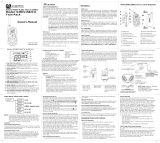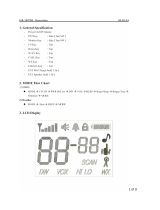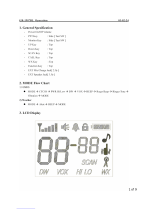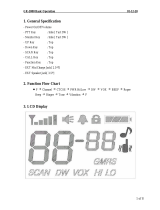Audiovox GMRS1100-2CH User manual
- Category
- Two-way radios
- Type
- User manual
This manual is also suitable for
Audiovox GMRS1100-2CH is a versatile and feature-rich GMRS radio transceiver that offers a wide range of capabilities for clear and reliable communication. With its compact design and intuitive controls, the GMRS1100-2CH is easy to use and can be conveniently carried around. The transceiver operates on four AAA batteries, providing extended operating time. It features 22 channels and 38 CTCSS privacy codes, allowing you to choose the most suitable channel and privacy setting for your communication needs.
Audiovox GMRS1100-2CH is a versatile and feature-rich GMRS radio transceiver that offers a wide range of capabilities for clear and reliable communication. With its compact design and intuitive controls, the GMRS1100-2CH is easy to use and can be conveniently carried around. The transceiver operates on four AAA batteries, providing extended operating time. It features 22 channels and 38 CTCSS privacy codes, allowing you to choose the most suitable channel and privacy setting for your communication needs.




















-
 1
1
-
 2
2
-
 3
3
-
 4
4
-
 5
5
-
 6
6
-
 7
7
-
 8
8
-
 9
9
-
 10
10
-
 11
11
-
 12
12
-
 13
13
-
 14
14
-
 15
15
-
 16
16
-
 17
17
-
 18
18
-
 19
19
-
 20
20
-
 21
21
-
 22
22
-
 23
23
-
 24
24
Audiovox GMRS1100-2CH User manual
- Category
- Two-way radios
- Type
- User manual
- This manual is also suitable for
Audiovox GMRS1100-2CH is a versatile and feature-rich GMRS radio transceiver that offers a wide range of capabilities for clear and reliable communication. With its compact design and intuitive controls, the GMRS1100-2CH is easy to use and can be conveniently carried around. The transceiver operates on four AAA batteries, providing extended operating time. It features 22 channels and 38 CTCSS privacy codes, allowing you to choose the most suitable channel and privacy setting for your communication needs.
Ask a question and I''ll find the answer in the document
Finding information in a document is now easier with AI
Related papers
-
Audiovox AH731R User manual
-
Audiovox GMRS120 User manual
-
Audiovox GMRS200W Owner's manual
-
Audiovox GMRS672CH Owner's manual
-
Audiovox GMRS1200CH User manual
-
Audiovox GMRS1222CH User manual
-
Audiovox GMRS122CH User manual
-
Audiovox FR-314 User manual
-
Audiovox GMRS1072CH Owner's manual
-
 Bonso Electronics OVVGMRS1072 User manual
Bonso Electronics OVVGMRS1072 User manual
Other documents
-
Memorex MK1995 User manual
-
 Genex Telecom PM3GR5000 User manual
Genex Telecom PM3GR5000 User manual
-
 Genex Telecom GR-1907BL User manual
Genex Telecom GR-1907BL User manual
-
Kenwood KBP-5 Installation guide
-
Columbia GMRS-1 User manual
-
 Genex GR-2000 User manual
Genex GR-2000 User manual
-
Shenzhen UT208 Digital Clamp Meter True User manual
-
Memorex MK-1700A User manual
-
Voyager GMRS200 User manual
-
Columbia FRS22SPR User manual



























